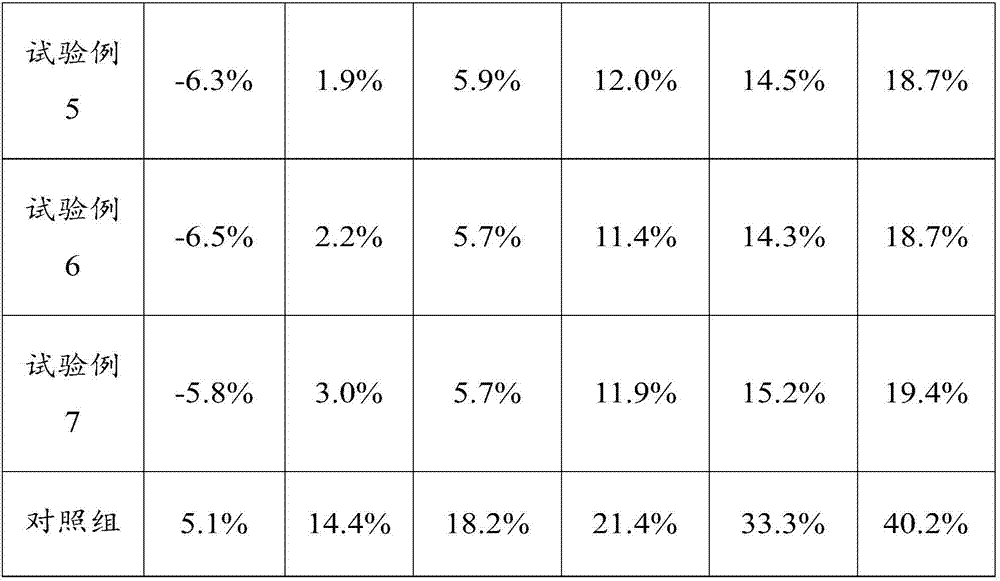Coating for bathroom and preparation method thereof
A coating and bathroom technology, which is applied in the field of bathroom coatings and its preparation, can solve the problems of different designs of items to be coated, limited types of coatings, etc., and achieve excellent antifouling ability, avoid the growth of bacteria and mold, and good corrosion inhibition and anti-scaling effect
- Summary
- Abstract
- Description
- Claims
- Application Information
AI Technical Summary
Problems solved by technology
Method used
Image
Examples
Embodiment 1
[0044] 34 parts by weight of thermosetting acrylic resin, 20 parts by weight of epoxy resin and 17 parts by weight of methylphenyl silicone resin were mixed at a rotation speed of 250 r / min to obtain a first mixture. Next, the above-mentioned first mixture was mixed with 7 parts by weight of auxiliary materials and 68 parts by weight of water at a rotation speed of 300 r / min to obtain a second mixture. The above second mixture was mixed with 12 parts by weight of lithopone at a rotation speed of 600 r / min to obtain a third mixture. Then the third mixture was mixed with 25 parts by weight of antibacterial agent to obtain the coating.
[0045] Among them, the auxiliary materials include butadienyl triethoxysilane, potassium lignosulfonate, cuprous oxide, water glass and EPDM rubber in a weight ratio of 4.3:3:0.05:1:0.5. The antibacterial agent includes dihydromyricetin, catechin and resveratrol in a weight ratio of 2:0.06:2.
Embodiment 2
[0047] 46 parts by weight of thermosetting acrylic resin, 27 parts by weight of epoxy resin and 26 parts by weight of methylphenyl silicone resin were mixed at a rotation speed of 280 r / min to obtain a first mixture. Next, the above-mentioned first mixture was mixed with 12 parts by weight of auxiliary materials and 88 parts by weight of water at a rotation speed of 500 r / min to obtain a second mixture. Among them, the auxiliary material contains gamma-glycidyl etheroxypropyl trimethoxysilane, potassium lignosulfonate, cuprous oxide, water glass and EPDM rubber with a weight ratio of 5:3.6:0.07:1.2:0.8.
[0048] The above second mixture was mixed with 18 parts by weight of lithopone at a rotation speed of 800 r / min to obtain a third mixture.
[0049] Dihydromyricetin, catechin and resveratrol in a weight ratio of 2:0.06:2 were mixed and ground to a particle size of 100 μm, then dissolved in an alcohol solution, and ultrasonically dispersed for 12 minutes to obtain a bacteriost...
Embodiment 3
[0052] 40 parts by weight of thermosetting acrylic resin, 23.5 parts by weight of epoxy resin and 21.5 parts by weight of methylphenyl silicone resin were mixed at a rotation speed of 265 r / min to obtain a first mixture. Next, the above-mentioned first mixture was mixed with 9.5 parts by weight of auxiliary materials and 78 parts by weight of water at a rotation speed of 400 r / min to obtain a second mixture. Among them, the auxiliary material contains a mixture of butadienyl triethoxysilane and γ-aminopropyl triethoxysilane with a weight ratio of 4.75:3.3:0.06:1.1:0.65, potassium lignosulfonate, cuprous oxide, Water glass and EPDM.
[0053] The above second mixture was mixed with 15 parts by weight of lithopone at a rotation speed of 700 r / min to obtain a third mixture.
[0054] Mix chitin and chitosan to obtain the first antibacterial substance. Dihydromyricetin, catechin and resveratrol in a weight ratio of 3:0.08:4 were mixed and ground to a particle size of 200 μm, then ...
PUM
 Login to View More
Login to View More Abstract
Description
Claims
Application Information
 Login to View More
Login to View More - R&D
- Intellectual Property
- Life Sciences
- Materials
- Tech Scout
- Unparalleled Data Quality
- Higher Quality Content
- 60% Fewer Hallucinations
Browse by: Latest US Patents, China's latest patents, Technical Efficacy Thesaurus, Application Domain, Technology Topic, Popular Technical Reports.
© 2025 PatSnap. All rights reserved.Legal|Privacy policy|Modern Slavery Act Transparency Statement|Sitemap|About US| Contact US: help@patsnap.com


